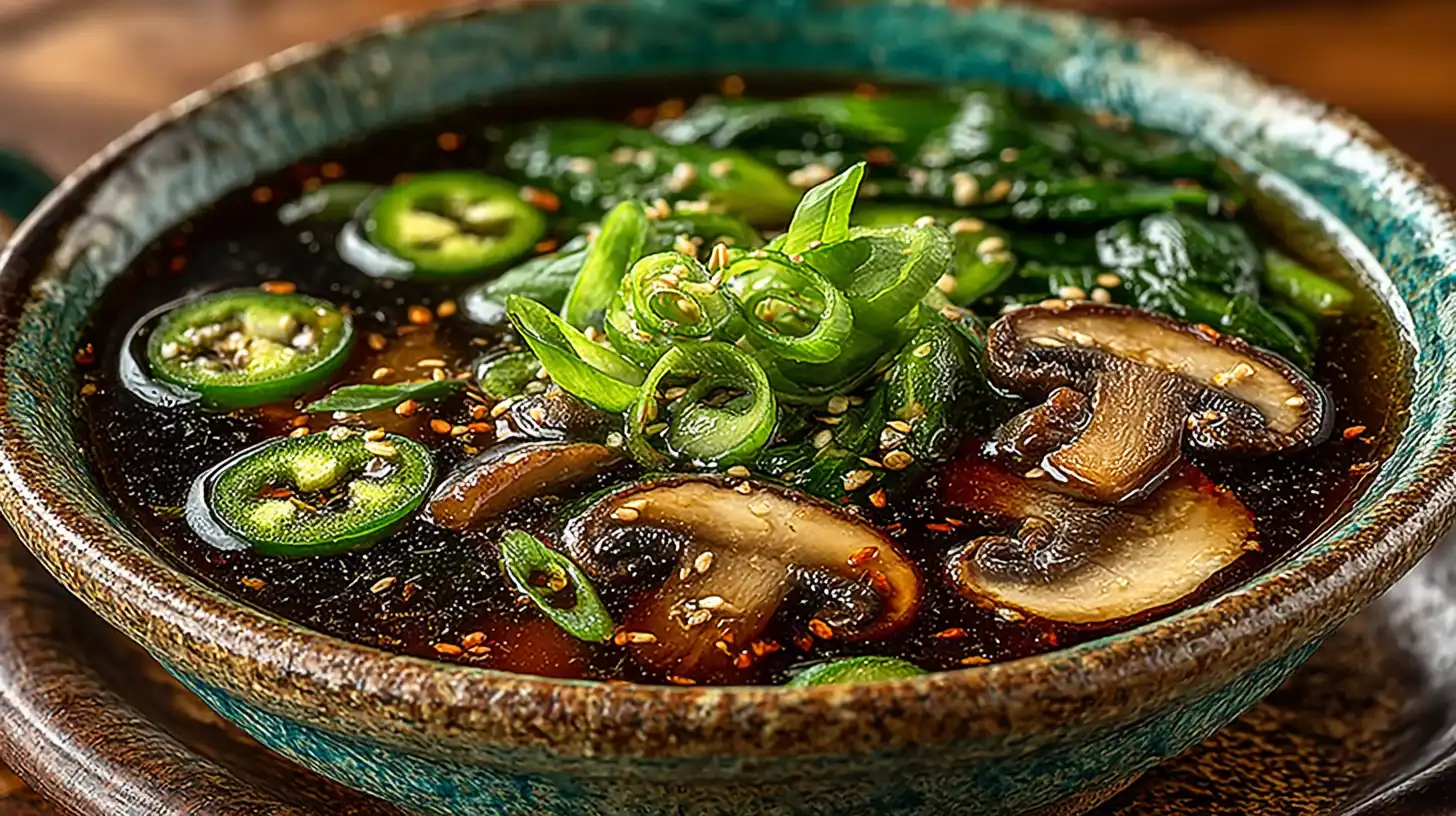Japanese clear soup recipe is more than just a warm bowl of broth—it’s a healing, minimalist culinary tradition packed with umami flavor and digestive benefits. Whether you’re preparing a light starter or aiming for a low-calorie comfort dish, this recipe delivers both wellness and flavor in every sip. Also known as osuimono or sumashi-jiru, this soup is a staple in many Japanese homes and restaurants.
In this guide, you’ll uncover how to make a traditional Japanese clear soup recipe from scratch, what ingredients give it its signature taste, and how it differs from other Japanese soups like miso. Plus, we’ll explore healthy twists, storage tips, and regional variations that make this dish both versatile and timeless.
Table of Contents
Table of Contents
Looking for inspiration? Try this Japanese Pink Salt and Ice Recipe to pair with your clear soup for a full detoxifying meal.
Introduction to Japanese Clear Soup
What Is Japanese Clear Soup?
A true Japanese clear soup recipe begins with a pure broth and carefully selected ingredients designed to highlight umami, not overpower it. This soup is known for its crystal-clear appearance and light, savory taste. Unlike richer soups like ramen or stews, this one is delicate and refined. The core of this soup is dashi, a broth made with kombu (seaweed) and katsuobushi (bonito flakes), known for being high in natural umami compounds.
The Japanese clear soup recipe is traditionally served as an appetizer, especially in sushi bars or during multi-course meals called kaiseki. It’s light enough to stimulate appetite without filling you up, making it an ideal prelude to heavier main dishes.
Origins and Cultural Importance
Rooted in centuries of tradition, the Japanese clear soup recipe holds a deep cultural significance. Its clarity and simplicity reflect the core values of Japanese cuisine—respect for ingredients, seasonal harmony, and minimalism. Historically used in formal occasions like tea ceremonies or weddings, this soup stands as a symbol of purity and elegance.
In Buddhist temple cuisine, the same style of clear soup is prepared without fish, often using dried mushrooms to create the umami base. This vegetarian approach to the Japanese clear soup recipe illustrates its flexibility and wide appeal across different diets and belief systems.
Today, it’s not just a ceremonial dish. Families prepare it at home for regular meals because it’s easy to digest, quick to make, and soothing—especially during flu season or digestive discomfort.
Check out this Natural Ozempic Drink Recipe to complement your healthy, gut-friendly soup routine.
Print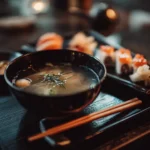
Japanese Clear Soup Recipe – Traditional, Healthy, and Easy to Make
- Total Time: 20 minutes
- Yield: 4 servings 1x
Description
A light, nourishing Japanese clear soup that’s incredibly simple to prepare and perfect for a quick, low-calorie start to any meal.
Ingredients
- 4 cups chicken broth (or vegetable broth for vegetarian)
- 2 cups water
- 1 garlic clove, minced
- 1/2 onion, sliced
- 1 carrot, sliced thinly
- 1 celery stalk, sliced
- 1 tbsp soy sauce
- 2 mushrooms (shiitake or white), thinly sliced
- Chopped scallions for garnish
- Optional: a few drops of sesame oil or a small piece of kombu
Instructions
- In a pot, combine broth and water. Bring to a boil.
- Add garlic, onion, carrot, celery, and mushrooms.
- Reduce heat and simmer for 10-15 minutes until vegetables are soft.
- Stir in soy sauce and optional sesame oil or kombu.
- Strain for a very clear broth if desired, or serve as is.
- Top with chopped scallions before serving.
Notes
This soup is perfect as an appetizer or a gentle detox meal. You can customize it by adding tofu or seaweed for more flavor and nutrition.
- Prep Time: 5 minutes
- Cook Time: 15 minutes
- Category: Soup
- Method: Stovetop
- Cuisine: Japanese
Nutrition
- Serving Size: 1 bowl
- Calories: 40
- Sugar: 2g
- Sodium: 550mg
- Fat: 1g
- Saturated Fat: 0g
- Unsaturated Fat: 1g
- Trans Fat: 0g
- Carbohydrates: 5g
- Fiber: 1g
- Protein: 3g
- Cholesterol: 0mg
Keywords: japanese clear soup, healthy broth, low calorie soup, miso alternative, healing soup
Ingredients Used in Authentic Japanese Clear Soup Recipe
Core Ingredients and Their Role in Japanese Clear Soup Recipe
A traditional Japanese clear soup recipe keeps things beautifully simple. The ingredients are minimal yet intentional, with each one contributing to the overall clarity and depth of the dish. Below is a breakdown of the essentials typically found in an authentic preparation:
| Ingredient | Function |
|---|---|
| Dashi (kombu + bonito flakes) | Forms the umami-rich base of the clear broth |
| Shiitake or enoki mushrooms | Adds earthy notes and visual elegance |
| Scallions or mitsuba | Brightens the flavor and adds freshness |
| Soy sauce (light) | Provides subtle depth and seasoning |
| Minimal salt | Enhances flavors while maintaining the soup’s lightness |
| Optional tofu, chicken, or fish cake | Adds protein and variation for texture and taste |
The dashi broth is where this dish begins—and often ends in terms of complexity. It’s what gives the Japanese clear soup recipe its unmistakable umami character. Kombu, a sea vegetable, contributes glutamates, while bonito flakes lend inosinates. Together, they create a deeply savory experience with absolutely no heaviness.
Mushrooms like shiitake or enoki enhance that depth with subtle earthy tones, while scallions add brightness and a crisp finish. Light soy sauce rounds out the flavor, avoiding the strong saltiness of darker varieties.
Discover great ideas like this Natural Ozempic Tea Recipe for more healthy, warming Japanese beverages.
Variations of Ingredients in Japanese Clear Soup Recipe
Despite its minimalist core, the Japanese clear soup recipe varies from region to region, and even chef to chef. Here are some notable variations:
Regional Adaptations
- Kyoto Style: Uses yuba (tofu skin) for elegance and a creamy texture.
- Osaka Style: Heavier on soy sauce and often includes sliced kamaboko (fish cake).
- Okinawan Style: Incorporates pork-based dashi or island vegetables.
Modern or Western Variations
- Westernized Broths: Some use low-sodium chicken broth in place of dashi.
- Added Aromatics: Ginger slices, garlic, or lemongrass may be used for depth.
- Vegetarian Alternatives: Replace bonito flakes with dried shiitake mushrooms to create a plant-based dashi.
These tweaks reflect the flexibility of the Japanese clear soup recipe while maintaining its health-conscious and flavorful identity.
Don’t miss our Bariatric Seed Diet Recipe for more options that align with gut health and clean eating.
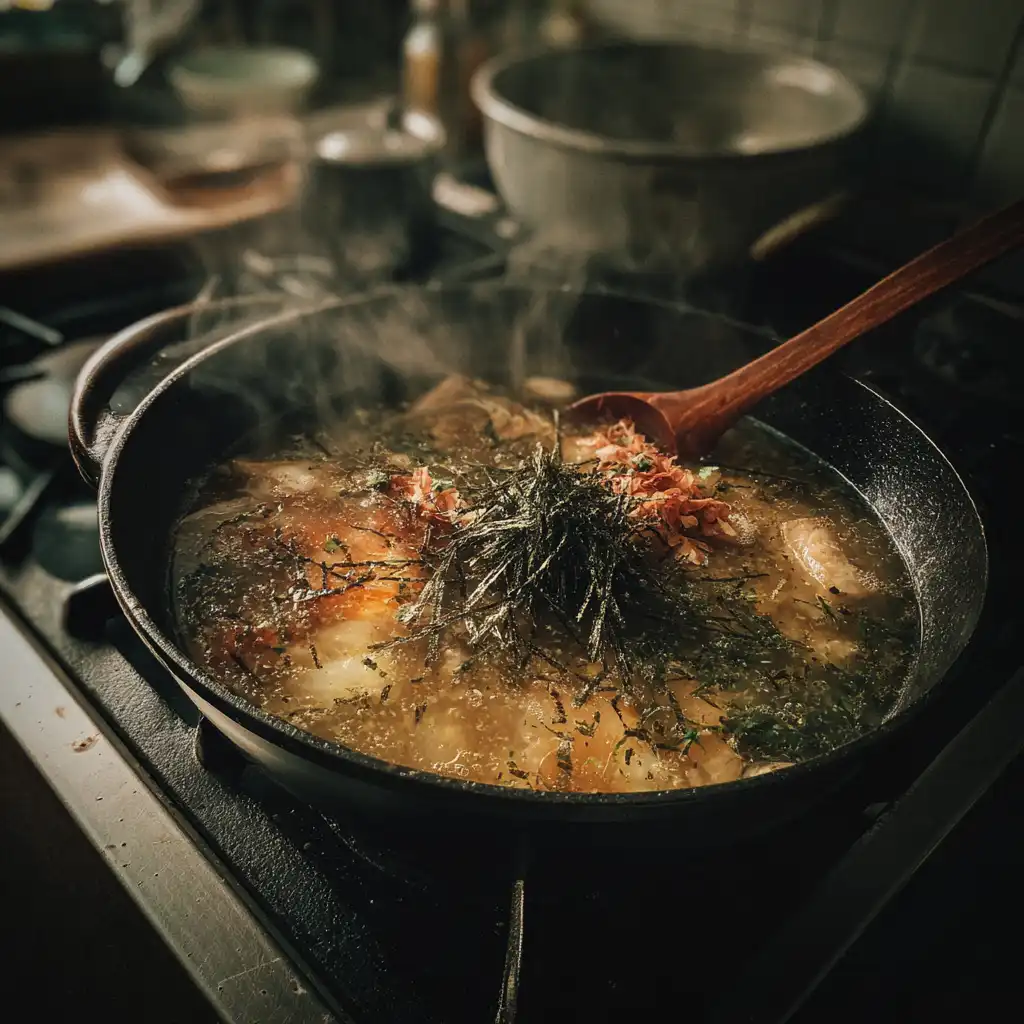
Step-by-Step Instructions for Japanese Clear Soup Recipe
How to Make Japanese Clear Soup at Home
Crafting an authentic Japanese clear soup recipe at home is easier than you might think. It takes just a few ingredients and a focus on gentle cooking to preserve the clarity of the broth. Below is a traditional method using dashi, mushrooms, and light seasoning:
Ingredients
- 4 cups dashi (made from kombu and bonito flakes or instant dashi granules)
- 2 teaspoons light soy sauce
- 1/4 teaspoon salt (or to taste)
- 4 small shiitake mushrooms (stems removed)
- 1/4 block soft tofu (cubed) – optional
- 2 tablespoons finely chopped scallions or mitsuba
Instructions
- Prepare the dashi
- If using instant dashi: dissolve the granules in hot water according to package instructions.
- For homemade dashi: soak a 4-inch piece of kombu in 4 cups of water for 30 minutes. Slowly bring to a near-boil, remove kombu, add a handful of bonito flakes, simmer 5 minutes, then strain.
- Simmer the base
- Place the dashi in a small pot over medium-low heat.
- Add mushrooms and tofu. Let simmer gently for 5–6 minutes. Don’t boil—keep it gentle to maintain broth clarity.
- Season the soup
- Add soy sauce and salt. Taste and adjust according to your preference.
- Garnish and serve
- Ladle the soup into small bowls.
- Sprinkle chopped scallions or mitsuba on top.
- Serve immediately while warm.
This Japanese clear soup recipe is ready in under 20 minutes and can be made ahead for batch cooking. Just store the broth separately from garnishes to maintain texture and appearance.
Check out this Brazilian Ozempic Apple Cider Vinegar Recipe for another wellness-boosting companion to your light Japanese soup meals.
Cooking Tips for the Perfect Umami Balance
Even though the recipe is simple, the magic lies in mastering these small details:
- Use filtered water for clearer broth.
- Avoid boiling once bonito flakes are added; boiling makes the soup cloudy.
- Slice mushrooms thinly so they cook fast and don’t overwhelm the dish.
- Add proteins like chicken or fish cakes after simmering, so they don’t cloud the broth.
Here’s a simple tip: if you want your Japanese clear soup recipe to shine at dinner parties, make the dashi a few hours ahead and refrigerate it. The flavors meld better when slightly aged.
Looking for more ideas? Try this Lemon Balm Natural Ozempic Recipe to pair with your soup for a calming, health-centered meal.
Japanese Clear Soup vs Miso Soup
Key Differences in Taste, Ingredients, and Appearance
While both beloved in Japanese cuisine, a Japanese clear soup recipe and a miso soup recipe couldn’t be more different when it comes to texture, flavor, and use. Understanding these distinctions helps you choose the right soup for your meal or health goals.
| Feature | Japanese Clear Soup | Miso Soup |
|---|---|---|
| Base | Dashi (kombu & bonito) | Dashi + miso paste |
| Appearance | Transparent, clear | Cloudy, opaque |
| Flavor Profile | Light, clean, umami-rich | Rich, savory, fermented |
| Main Ingredients | Mushrooms, scallions, tofu | Tofu, seaweed, green onions |
| Fermented Content | None | Yes (miso paste) |
| Common Use | Appetizer, ceremonial meals | Everyday breakfast, homestyle meals |
| Sodium Content | Lower (depends on soy/salt) | Higher (from miso paste) |
| Gut Health Properties | Gentle on stomach | Contains probiotics |
The Japanese clear soup recipe is typically served before a meal to awaken the palate without overloading it. Miso soup, in contrast, is heartier and often enjoyed as part of a main breakfast or lunch in Japanese homes.
Miso adds not just flavor but fermentation, which makes it cloudy and heavier. This difference also impacts shelf life—Japanese clear soup doesn’t ferment, so it’s better for those on low-sodium or bland diets.
When to Serve Each in a Traditional Japanese Meal
A Japanese clear soup recipe fits best in situations that call for subtlety:
- Sushi restaurants where it refreshes the taste buds between courses
- Formal events where light, symbolic dishes are preferred
- Detox or fasting periods where clarity and digestion are priorities
Miso soup is more everyday and versatile, suitable for:
- Quick breakfasts with rice and fish
- Home meals with leftover ingredients
- Gut support via fermented nutrients
If you’re focused on gentle digestion, the Japanese clear soup recipe is ideal. For flavor depth and probiotic benefits, miso soup takes the lead.
Don’t miss our Japanese Pink Salt Diet Recipe—a great addition if you’re balancing light soups with detox-friendly foods.
Health Benefits of Japanese Clear Soup Recipe
Nutritional Profile and Low-Calorie Advantages
One of the most appealing aspects of the Japanese clear soup recipe is how healthy it is—especially for those watching calories, sodium, or following digestive wellness plans. Because it’s broth-based and relies on umami rather than fats or heavy seasonings, this soup delivers flavor without the guilt.
Here’s a snapshot of its typical nutritional value per 1-cup serving:
| Nutrient | Amount |
|---|---|
| Calories | 20–35 kcal |
| Sodium | ~300–500 mg (depending on soy) |
| Protein | ~2 g (from tofu/mushrooms) |
| Fat | <1 g |
| Carbohydrates | ~2–4 g |
| Fiber | Trace amounts |
Low in fat, free from added sugars, and high in hydration, this soup is ideal for intermittent fasting windows, post-illness recovery, and light dinner pairings. The Japanese clear soup recipe also works well for bariatric diets, weight loss plans, and anti-inflammatory meal prep.
Its gentle nature makes it easy on the stomach, helping reduce bloating or discomfort after heavy meals.
Gut Health and Digestive Aid Comparison with Miso Soup
While miso soup gets praise for its probiotic content, the Japanese clear soup recipe shines in terms of being gentle and bloat-free. Here’s how they compare for gut support:
| Aspect | Japanese Clear Soup | Miso Soup |
|---|---|---|
| Probiotics | No | Yes (fermented miso paste) |
| Ease on Digestion | Very gentle, easy to absorb | Can be heavier for sensitive guts |
| Sodium Levels | Typically lower | Higher due to fermented ingredients |
| Ideal For | Fasting, recovery, low-sodium diets | Daily gut flora maintenance |
For individuals managing GERD, IBS, or recovering from stomach bugs, the Japanese clear soup recipe is a go-to option due to its clean, non-irritating broth.
Looking for inspiration? Try this Bariatric Pumpkin Seed Tea Recipe for another light, stomach-friendly recipe option.
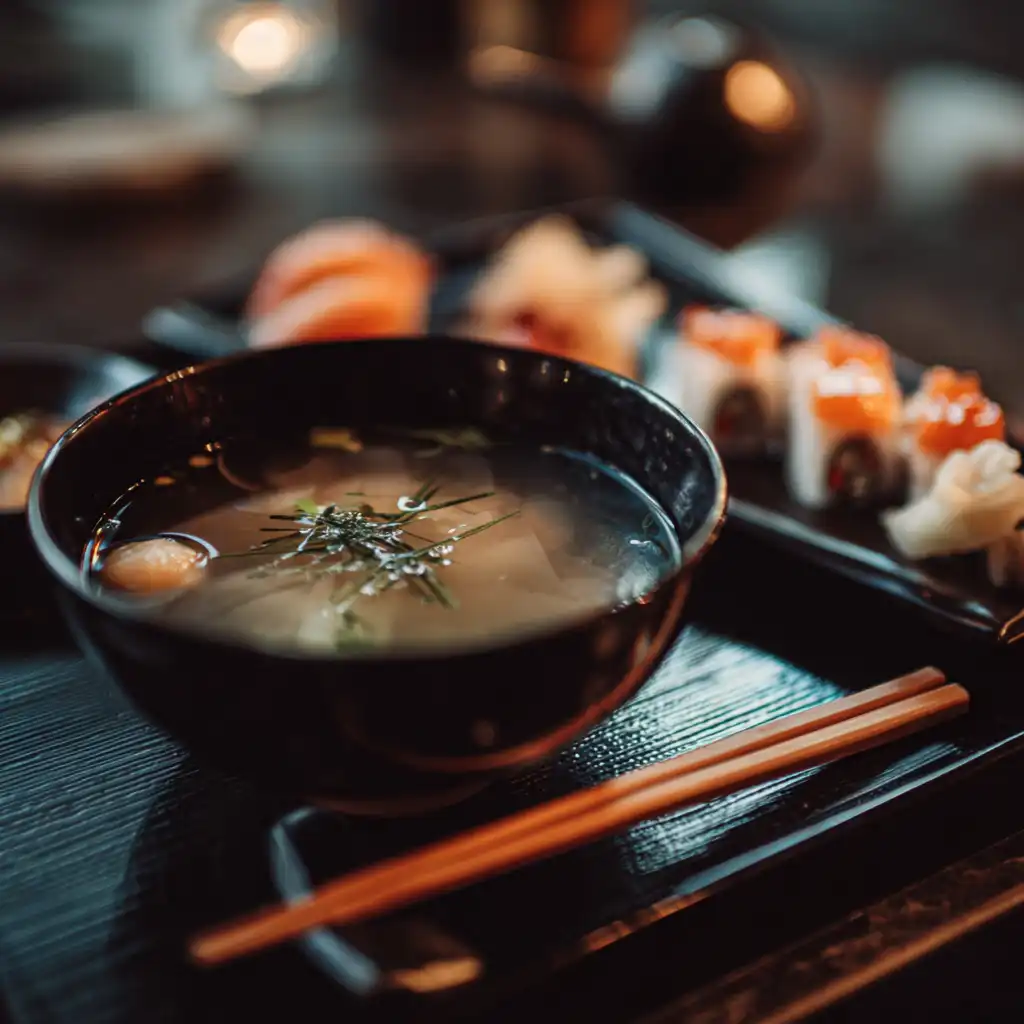
Serving Suggestions and Meal Pairings for Japanese Clear Soup Recipe
What Goes Best with Japanese Clear Soup Recipe?
The elegance of a Japanese clear soup recipe makes it a versatile addition to a wide variety of meals. Because it’s mild and refreshing, it complements dishes without overpowering them. Whether you’re serving a multi-course Japanese meal or a simple lunch, this soup works as a perfect opener or a gentle side.
Here are some top pairings:
| Dish Type | Examples |
|---|---|
| Appetizers | Edamame, pickled daikon, gyoza |
| Main Courses | Grilled fish (like salmon or mackerel), teriyaki chicken |
| Rice Dishes | Sushi rolls, chirashi bowls, steamed jasmine rice |
| Noodle Plates | Cold soba, yakisoba |
| Plant-Based Sides | Steamed bok choy, miso eggplant, seaweed salad |
Serving this soup warm in small lacquered bowls adds authenticity and elegance to your presentation.
Check out this Toasted Marshmallow Recipe for a comforting dessert that pairs surprisingly well with light soup-based meals.
Presentation Tips and Serving Temperature
Presentation plays a big role in elevating the Japanese clear soup recipe from simple to stunning. Here’s how to do it right:
- Use transparent bowls: Show off the clarity and floating ingredients.
- Add a sprig of mitsuba or a thin carrot flower: Offers visual charm and seasonal symbolism.
- Serve piping hot: A clear soup loses aroma quickly when lukewarm.
- Pair with warm towels (oshibori): For a traditional Japanese touch before the meal.
Timing is key too—always serve this soup immediately after assembling. Reheating can dull the flavors and reduce clarity.
If you’re preparing a light meal for someone recovering from illness or looking to detox, pair this soup with steamed white rice and lightly grilled tofu or fish.
Don’t miss our Bariatric Seed Tonic Recipe for another nourishing, low-impact pairing idea that promotes digestion and wellness.
Storage and Make-Ahead Tips for Japanese Clear Soup Recipe
How Long Does Japanese Clear Soup Last?
A key benefit of the Japanese clear soup recipe is its flexibility—you can prepare the broth in advance and assemble servings on demand. When stored correctly, the soup remains fresh and flavorful for several days.
Here’s a quick guide to storage timelines:
| Storage Method | Shelf Life |
|---|---|
| Refrigerator (broth only) | 3–4 days |
| Refrigerator (fully assembled) | 1–2 days (before ingredients soften) |
| Freezer (broth only) | Up to 2 months |
Pro tip: Always strain out mushrooms, scallions, and tofu before storing the broth to prevent cloudiness and spoilage. Add fresh garnishes only when reheating and serving.
The dashi base used in the Japanese clear soup recipe can even be prepared in larger batches, then frozen in small containers or ice cube trays for quick use later.
Freezing, Reheating, and Freshness Preservation
To retain the clarity and delicate flavor of the Japanese clear soup recipe, follow these preservation tips:
Freezing Tips
- Cool the broth completely before transferring to freezer-safe containers.
- Avoid freezing tofu or fresh mushrooms—they’ll become mushy upon thawing.
- Label each container with the freeze date.
Reheating Tips
- Reheat over medium-low heat—avoid boiling.
- Stir gently to keep the broth clear.
- Add fresh toppings like scallions, tofu, or mushrooms only once hot.
Reheating in the microwave isn’t ideal for this recipe; it can overcook or cloud the broth. Stick to stovetop warming for the best texture and taste.
Looking for clean, gut-friendly meals? Try this Natural Ozempic Juice Recipe alongside your reheated soup for a complete wellness-focused lunch.
Regional and Modern Variations of Japanese Clear Soup Recipe
Common Restaurant-Style Variations
The Japanese clear soup recipe may follow a traditional formula, but chefs across Japan and around the world have added their own creative twists. These variations reflect both regional traditions and modern culinary innovation—making the dish as diverse as it is timeless.
Popular Restaurant Adaptations:
- Teppanyaki Soup (Hibachi-style): Often served in Japanese steakhouses in the U.S., featuring a rich dashi base with sautéed onions, carrots, and garlic.
- Osaka Variation: Stronger soy sauce presence with additions like kamaboko (fish cake) and thin yuba strips.
- Kyoto Style: Lighter seasoning, often omitting soy sauce to highlight seasonal vegetables and tofu skins.
- Tokyo Style: Features finely julienned vegetables like daikon and includes shimeji mushrooms for added complexity.
These variations may slightly differ in salt levels or visual presentation, but all stay true to the essence of the Japanese clear soup recipe—a clean, comforting, and umami-forward broth.
Check out this Homemade Mounjaro Recipe with Pink Salt for another creative twist on tradition that promotes balance and health.
Vegan, Keto, and Gluten-Free Twists
Modern dietary needs have led to several adaptations of the Japanese clear soup recipe for people following specific lifestyles:
Vegan Variation
- Dashi Substitution: Replace bonito flakes with dried shiitake mushrooms or kombu-only broth.
- Protein: Use cubed firm tofu or edamame.
- Flavor Enhancers: Add a touch of miso for umami without fish.
Keto-Friendly Version
- Broth: Stick to kombu or bone broth bases.
- Add-ins: Include low-carb veggies like zucchini noodles or bok choy.
- Avoid: Traditional noodles, corn, and high-carb mushrooms.
Gluten-Free Adaptation
- Soy Sauce Swap: Use tamari or gluten-free soy sauce.
- Watch Additives: Some instant dashi may contain gluten—check labels carefully.
These modern spins allow anyone to enjoy a Japanese clear soup recipe without sacrificing dietary goals. Whether you’re eating clean, cutting carbs, or eliminating animal products, there’s a version of this soup that works beautifully for your table.
Don’t miss our Natural Ozempic Drink Recipe for another easy-to-modify health drink that supports a clean, flexible diet.
Common Mistakes and How to Avoid Them in Japanese Clear Soup Recipe
Overboiling, Overseasoning, and Broth Clarity Issues
Even though a Japanese clear soup recipe looks simple, a few easy-to-make mistakes can affect its quality—especially the clarity and taste that define it. Here’s how to sidestep the most common pitfalls:
1. Boiling the Dashi
The biggest mistake? Letting your dashi boil. Boiling causes the kombu to release bitter compounds and the bonito flakes to cloud the broth.
Solution: Always simmer gently and remove kombu just before the water boils. Bonito flakes should steep briefly, never boil.
2. Overseasoning
This soup is meant to be subtle. Adding too much soy sauce or salt can ruin the clean, umami profile.
Solution: Start with a small amount of seasoning and taste as you go. Use light soy sauce to preserve color and balance.
3. Using Cloudy Add-ins
Certain vegetables, meats, or starches like potatoes can break down in hot broth and cloud the soup.
Solution: Stick to firm mushrooms, tofu, and leafy garnishes. Always strain the broth before serving.
4. Cooking Ingredients Too Long
Overcooking tofu or mushrooms will cause texture loss and dull the flavor.
Solution: Add delicate ingredients at the end of cooking. Simmer just enough to heat through.
Best Practices for First-Time Soup Makers
If it’s your first time attempting a Japanese clear soup recipe, here are a few expert-approved strategies to keep your soup crystal-clear and full of umami:
- Use filtered water: Avoid tap water with strong minerals or chlorine that may affect taste.
- Make dashi fresh: Pre-made dashi can work, but freshly made kombu-bonito stock tastes cleaner.
- Prep ingredients carefully: Wipe kombu clean but don’t wash—its surface white powder is loaded with umami.
- Keep portions small: Serving in smaller bowls enhances aroma and presentation.
Lastly, remember: clarity is both visual and flavor-based in this soup. Aim for balance, lightness, and elegance over intensity.
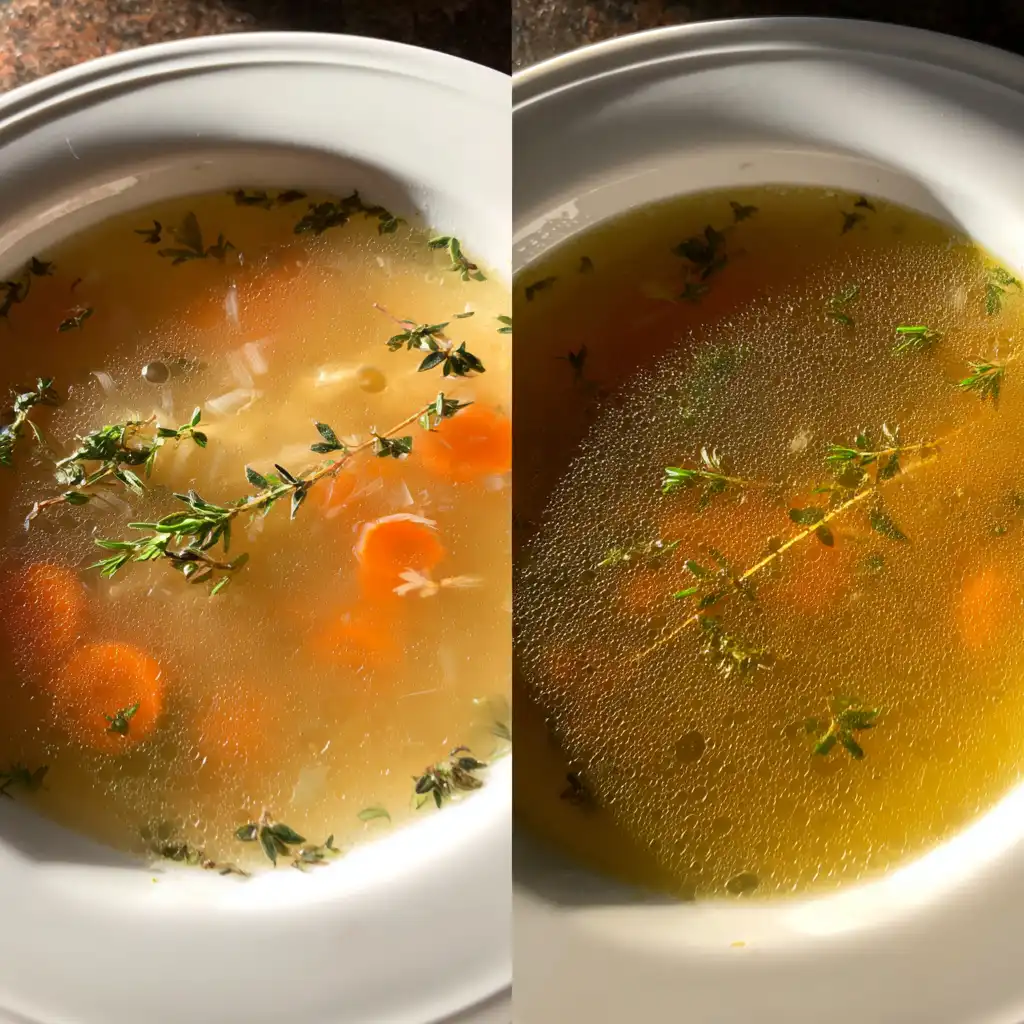
Discover more expert tips in our What Is Butter Chicken Sauce Made Of?—a perfect guide for elevating sauces and broths with precision.
Frequently Asked Questions About Japanese Clear Soup Recipe
What is Japanese Clear Soup made of?
The classic Japanese clear soup recipe consists of dashi broth made from kombu (dried seaweed) and bonito flakes, with light additions like shiitake mushrooms, scallions, and optional tofu or fish cake. Its simplicity highlights the natural umami flavor of the ingredients.
What is the difference between Japanese Clear Soup and miso soup?
The Japanese clear soup recipe creates a transparent, delicate broth, while miso soup is cloudier and richer due to the addition of fermented soybean paste. Clear soup is often lighter in flavor and sodium, making it ideal for appetizers or sensitive stomachs.
How to make a clear soup?
Start with dashi or a light vegetable broth, simmer mushrooms and tofu gently, and season with a touch of soy sauce and salt. Garnish with scallions or mitsuba before serving. Avoid boiling to maintain clarity.
What’s healthier, miso soup or clear soup?
While miso soup contains probiotics from fermentation, the Japanese clear soup recipe is lower in calories and sodium. It’s gentler on the digestive system and preferred for detox, illness recovery, or light meals.
What soup is best for gut health?
For gut health, both have merits. Miso soup offers probiotics, while the Japanese clear soup recipe is easier to digest and soothing for those with IBS, GERD, or post-illness fatigue. Choose based on your body’s tolerance and needs.
Conclusion: Why You Should Try a Japanese Clear Soup Recipe Today
The Japanese clear soup recipe is more than just broth—it’s a celebration of simplicity, wellness, and flavor. Whether you’re seeking a light start to a meal, a healing soup for recovery, or an elegant dish for guests, this recipe checks all the boxes.
From traditional ingredients like dashi and shiitake mushrooms to vegan and keto-friendly variations, the soup adapts to modern lifestyles without compromising authenticity. It’s quick to make, easy to digest, and beautiful to serve.
Start experimenting with your own version of this comforting classic. And while you’re at it, don’t miss our Zepbound Recipe for Weight Loss to complement your clean eating goals.
Follow Kamala Recipes for exclusive recipes that balance hormones, reduce cravings, and support sustainable weight loss—every single day.

